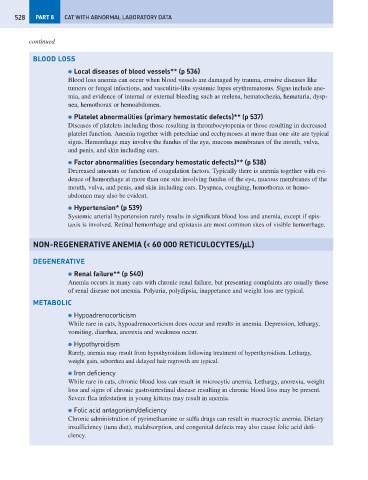Page 536 - Problem-Based Feline Medicine
P. 536
528 PART 8 CAT WITH ABNORMAL LABORATORY DATA
continued
BLOOD LOSS
● Local diseases of blood vessels** (p 536)
Blood loss anemia can occur when blood vessels are damaged by trauma, erosive diseases like
tumors or fungal infections, and vasculitis-like systemic lupus erythrematosus. Signs include ane-
mia, and evidence of internal or external bleeding such as melena, hematochezia, hematuria, dysp-
nea, hemothorax or hemoabdomen.
● Platelet abnormalities (primary hemostatic defects)** (p 537)
Diseases of platelets including those resulting in thrombocytopenia or those resulting in decreased
platelet function. Anemia together with petechiae and ecchymoses at more than one site are typical
signs. Hemorrhage may involve the fundus of the eye, mucous membranes of the mouth, vulva,
and penis, and skin including ears.
● Factor abnormalities (secondary hemostatic defects)** (p 538)
Decreased amounts or function of coagulation factors. Typically there is anemia together with evi-
dence of hemorrhage at more than one site involving fundus of the eye, mucous membranes of the
mouth, vulva, and penis, and skin including ears. Dyspnea, coughing, hemothorax or hemo-
abdomen may also be evident.
● Hypertension* (p 539)
Systemic arterial hypertension rarely results in significant blood loss and anemia, except if epis-
taxis is involved. Retinal hemorrhage and epistaxis are most common sites of visible hemorrhage.
NON-REGENERATIVE ANEMIA (< 60 000 RETICULOCYTES/mL)
DEGENERATIVE
● Renal failure** (p 540)
Anemia occurs in many cats with chronic renal failure, but presenting complaints are usually those
of renal disease not anemia. Polyuria, polydipsia, inappetance and weight loss are typical.
METABOLIC
● Hypoadrenocorticism
While rare in cats, hypoadrenocorticism does occur and results in anemia. Depression, lethargy,
vomiting, diarrhea, anorexia and weakness occur.
● Hypothyroidism
Rarely, anemia may result from hypothyroidism following treatment of hyperthyroidism. Lethargy,
weight gain, seborrhea and delayed hair regrowth are typical.
● Iron deficiency
While rare in cats, chronic blood loss can result in microcytic anemia. Lethargy, anorexia, weight
loss and signs of chronic gastrointestinal disease resulting in chronic blood loss may be present.
Severe flea infestation in young kittens may result in anemia.
● Folic acid antagonism/deficiency
Chronic administration of pyrimethamine or sulfa drugs can result in macrocytic anemia. Dietary
insufficiency (tuna diet), malabsorption, and congenital defects may also cause folic acid defi-
ciency.

